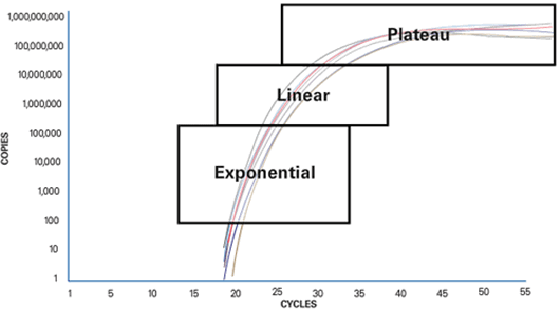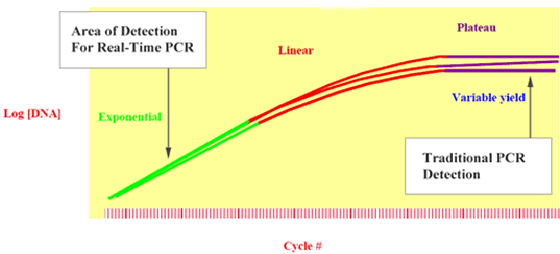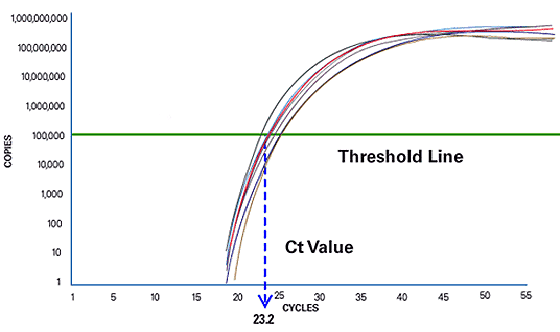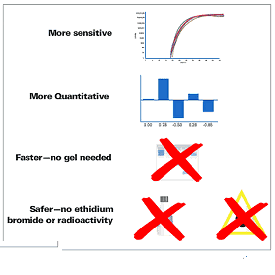Search
- Introduction
- Real-time PCR vs. traditional PCR vs. digital PCR at a glance
- Traditional PCR measures at the plateau, giving you variable results
- Real-time PCR measures at the exponential phase for more accurate quantitation
- Digital PCR counts individual molecules for absolute quantification
- Applied Biosystems TaqMan probe- and SYBR Green–based detection
- Applied Biosystems has a full range of real-time PCR products for routine and challenging applications
| Digital PCR | Real-time PCR | Traditional PCR | |
|---|---|---|---|
Overview microreactions | Measures the fraction of negative microreactions to determine absolute copies. | Measures PCR amplification as it occurs. | Measures the amount of accumulated PCR product at the end of the PCR cycles. |
Quantitative? microreactions | Yes, the fraction of negative microreactions is fit to a Poisson statistical algorithm. | Yes, because data is collected during the exponential growth (log) phase of PCR when the quantity of the PCR product is directly proportional to the amount of template nucleic acid. | No, though comparing the intensity of the amplified band on a gel to standards of a known concentration can give you 'semi-quantitative' results. |
| Applications |
|
| Amplification of DNA for:
|
| Summary | Advantages of digital PCR:
| Advantages of real-time PCR:
| Disadvantages of traditional PCR:
|
To understand why traditional PCR is limiting, it is important to understand what happens during a PCR reaction. A basic PCR run can be broken up into three phases:
Exponential
Exact doubling of product is accumulating at every cycle (assuming 100% reaction efficiency). The reaction is very specific and precise. Exponential amplification occurs because all of the reagents are fresh and available, the kinetics of the reaction push the reaction to favor doubling of amplicon.
Linear (high variability)
As the reaction progresses, some of the reagents are being consumed as a result of amplification. The reactions start to slow down and the PCR product is no longer being doubled at each cycle.
Plateau (End-point: gel detection for traditional methods)
The reaction has stopped, no more products are being made and if left long enough, the PCR products will begin to degrade. Each tube or reaction will plateau at a different point, due to the different reaction kinetics for each sample. These differences can be seen in the plateau phase. The plateau phase is where traditional PCR takes its measurement, also known as end-point detection.

Figure 1: PCR phases.
In Figure 2, three replicate samples, which had same amount of DNA in the beginning of the reaction, have different quantities of PCR product by the plateau phase of the reaction (due to variations in reaction kinetics). Therefore, it will be more precise to take measurements during the exponential phase, where the replicate samples are amplifying exponentially.

Figure 2: Identical samples produce different quantities of reaction product by the plateau phase of PCR.
Real-time PCR focuses on the exponential phase because it provides the most precise and accurate data for quantitation. Within the exponential phase, the real-time PCR instrument calculates two values. The Threshold line is the level of detection at which a reaction reaches a fluorescent intensity above background. The PCR cycle at which the sample reaches this level is called the Cycle Threshold, Ct. The Ct value is used in downstream quantitation or presence/absence detection. By comparing the Ct values of samples of unknown concentration with a series of standards, the amount of template DNA in an unknown reaction can be accurately determined.

Figure 3: The PCR cycle at which the sample reaches a fluorescent intensity above background is the Cycle Threshold or Ct.
Digital PCR works by digitizing a sample into many individual real-time PCR reactions; some portion of these microreactions contain the target molecule (positive) while others do not (negative). Following PCR analysis, the fraction of negative answers is used to generate an absolute answer for the exact number of target molecules in the sample, without reference to standards or endogenous controls.

Figure 4: Digital PCR uses the ratio of positive (black) to negative (white) microreactions to count the number of target molecules.
Every real-time PCR reaction contains a fluorescent reporter molecule—an Applied Biosystems™ TaqMan® probe or SYBR™ Green dye, for example—to monitor the accumulation of PCR product. As the quantity of target amplicon increases, so does the amount of fluorescence emitted from the fluorophore.

Figure 5: Advantages of real-time PCR vs. traditional PCR.
Applied Biosystems has a full range of real-time PCR products for routine and challenging applications
Applied Biosystems offers a comprehensive set of products for real-time PCR-based gene expression, miRNA, copy number variation, and SNP genotyping analysis, from off-the-shelf gene-specific probe and primer sets, to everyday reagents and plastics, instrument systems, software, and everything in between.
For Research Use Only. Not for use in diagnostic procedures.